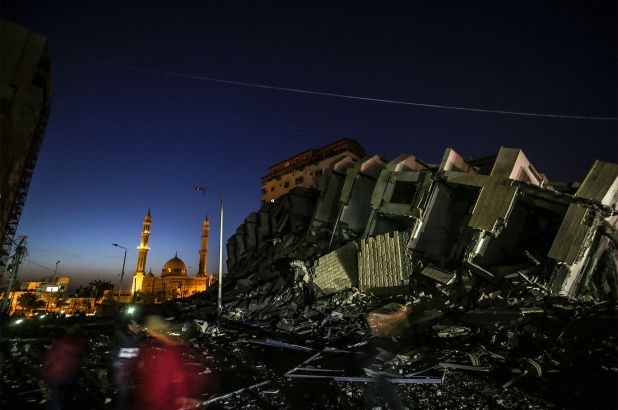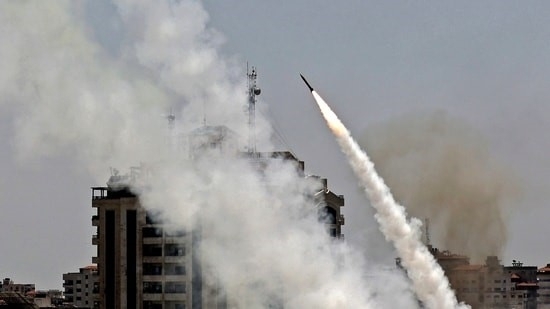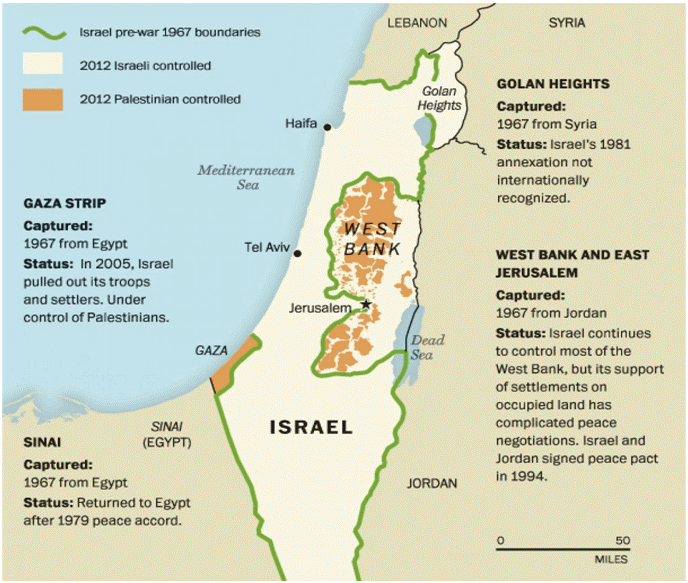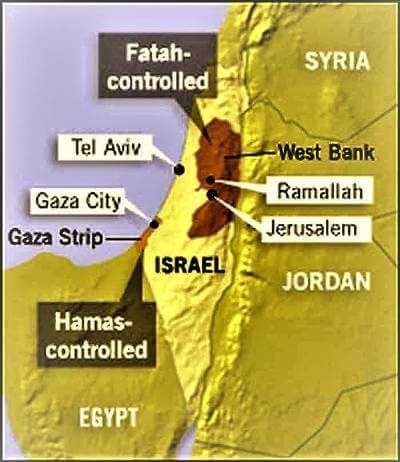Israel-Palestine Conflict: Why Israel and Hamas are firing missiles at each other?
Context
- Israel and Hamas exchanged heavy fire on Tuesday, 11th May 2021, with 35 Palestinians killed in Gaza and five in Israel, in a dramatic escalation between the bitter rivals sparked by unrest at Jerusalem’s flashpoint Al-Aqsa Mosque compound.
- Hamas militants in the Gaza Strip fired rockets toward Jerusalem on Monday, setting off air raid sirens throughout the city, after hundreds of Palestinians were hurt in clashes with Israeli police at a flashpoint religious site in the contested holy city.
- Abu Obeida, spokesman for Hamas’ military wing, said the rocket attack was a response to what he called Israeli “crimes and aggression” in Jerusalem. “This is a message the enemy has to understand well,” he said.
- Israeli Prime Minister Benjamin Netanyahu warned that militants would pay a “very heavy” price for the rockets.

WHAT HAS HAPPENED NOW?

- The recent clashes erupted on April 12, after Israeli police put up blockades to prevent people from gathering in huge numbers at the Damascus Gate Plaza in the part of East Jerusalem that's under Israel's control.
- The Damascus Gate Plaza has been a popular gathering place for Palestinian Muslims during the month of Ramzan. Israel feared trouble and tried to curtail the gathering.
- Four days later on April 16, Israel imposed a limit of 10,000 people for prayer gathering at the Al-Aqsa. Tens of thousands of Palestinians had headed to the mosque for prayers. They all were sent back.
- Most recently, the tensions have been fuelled by the planned eviction of dozens of Palestinians from the Sheikh Jarrah neighbourhood of east Jerusalem where Israeli settlers have waged a lengthy legal battle to take over properties.
VIOLENCE CONTINUES
- Violence has aggravated since then. More than 200 people were injured on May 7 in clashes at Al-Aqsa. Later, Palestinians were reported to have driven out Jewish families settled in Sheikh Jarrah.
- In retaliation, Israel on May 9 announced deferment of a hearing on the dispute of land ownership of Sheikh Jarrah. Grenades and rockets were fired on Monday. Israel launched airstrikes to push back Palestinian fighters and protesters.
- May 10 was a national holiday in Israel to mark Jerusalem Day, which celebrates the annexation of the city. Thousands of Israelis usually march in the Old City including areas densely settled by Palestinian Muslims. The day saw increasing clashes this year.
Background of the recent conflict

- Israelis and Palestinians are firing at each other in Jerusalem's Old City near Al-Aqsa. The violence that began as clashes between Israeli security forces and Palestinians a month ago has now turned into rocket and airstrikes from the two sides.
- Al-Aqsa - a mosque - is considered to be the third holiest site in Islam. But the compound - called Haram al-Sharif by Muslims - is equally holy for Jews, who refer to it as the Temple Mount.
RELIGION
- Al-Aqsa means the farthest mosque in English. Muslims believe that Prophet Muhammad travelled from Mecca to Al-Aqsa during the Night Journey (Al-Isra) and continued thereafter to heaven. The mosque is built on a hilltop, often called the walled plateau.
- The walled plateau also hosts the Temple Mount, which is one of the holiest places for Jews. They believe it was built during biblical times. The Romans destroyed it in 70 AD leaving only its western part. The Jews revere this wall.
- Both Israelis and Muslims of Palestine and rest of the Arab region stake their claim on the walled plateau. It is one of the disputed points that have prevented a settlement between Israel and Palestine.
TERRITORY
- At the core of the Israel-Palestine violence are Israel's attempt to limit gatherings at Al-Aqsa and a dispute over land ownership in Sheikh Jarrah in Jerusalem. It is a dispute that dates back to the formation of Israel in 1948. The dispute gained more momentum after 1956, when Israel won the first Arab War.
- Back then, the area where the mosque is located was under the control of Jordan, which worked with the United Nations to resettle Palestinian families that had been uprooted by the Israeli conquest in 1956.
- However, Israel established dominance over this area in another Arab War in 1967, when it occupied the West Bank, where the Old City of Jerusalem - also called East Jerusalem - is located. The name, West Bank, was given to it because of its location on the west of River Jordan.
- Israel has maintained its dominance in the region for over five decades now. Several mediation attempts have failed to find an amicable settlement between Israel and Palestine.
- Al-Aqsa has been a site of clashes for years. In 2000, Israeli forces stormed the mosque compound to suppress a Palestinian uprising. The month of Ramzan has historically seen an uptick in clashes in the area.
Does Israel want to take full control of the site?
- Israeli officials, including Prime Minister Benjamin Netanyahu, have said they do not intend to change the status quo.
- But some Israeli religious groups have long pressed for the right to pray at the site. In April, Jordan’s Foreign Ministry formally complained about large numbers of Jewish visitors to the site, calling it a violation of the status quo.
Reaction of the World to recent firings of missiles
USA
- USA condemned ongoing rocket attacks by Hamas and other groups against targets in Israel and said Israel has a legitimate right to defend itself.
- Jerusalem, a city of such importance to people of faith around the world, must be a place of co-existence.
- Primary US focus is on de-escalation.
U.N.
- N. Secretary-General Antonio Guterres is demanding an immediate halt to the “spiraling escalation” in Israeli-Palestinian violence.
- A spokesman says the United Nations “is working with all relevant parties to de-escalate the situation urgently.”
- UN is gravely concerned by the upsurge in violence, and is deeply saddened to learn of increasingly large numbers of casualties, including children, from Israeli airstrikes in Gaza, and of Israeli fatalities from rockets launched from Gaza.
- The U.N. Security will hold emergency consultations Wednesday on the escalating violence between Palestinians and Israelis. The U.N. Mideast envoy, Tor Wennesland, is expected to brief the 15 council members virtually at the closed meeting, which is being called at the request of China, Tunisia and Norway.
Where is West Bank?
It is a landlocked territory near the Mediterranean coast of Western Asia, bordered by Jordan to the east and by the Green Line separating it and Israel on the south, west and north. The West Bank also contains a significant section of the western Dead Sea shore.

- The West Bank was captured by Jordan after the 1948 Arab-Israeli War.
- Israel snatched it back during the Six Day War of 1967, and has occupied it ever since.
- It has built some 130 formal settlements in the West Bank, and a similar number of smaller, informal settlements have mushroomed over the last 20-25 years.
- Over 4 lakh Israeli settlers — many of them religious Zionists who claim a Biblical birthright over this land — now live here, along with some 26 lakh Palestinians.

Are these settlements illegal?
- The United Nations General Assembly, the UN Security Council, and the International Court of Justice have said that the West Bank settlements are violative of the Fourth Geneva Convention.
- Under the Fourth Geneva Convention (1949), an occupying power “shall not deport or transfer parts of its own civilian population into the territory it occupies”.
- Under the Rome Statute that set up the International Criminal Court in 1998, such transfers constitute war crimes, as does the “extensive destruction and appropriation of property, not justified by military necessity and carried out unlawfully and wantonly”.
Gaza Strip:
- The Gaza Strip is a small territory along the Mediterranean coast between Egypt and Israel.
- Palestine has staked claim to both the territories i.e. West Bank and Gaza Strip. But Israel’s objective has been to keep expanding Jewish settlements in these regions.
Background of the Conflict
- Israel occupied the West Bank and Gaza and annexed east Jerusalem following the 1967 Six Day War. It withdrew from Gaza in 2005 but severely restricts the flow of goods and people from the enclave.
- Israeli governments have said they could withdraw from parts of the West Bank depending on the terms of a peace deal with the Palestinians.
- But nearly half a million Jewish Israelis live in settlements on West Bank land Palestinians hope will be part of their future state.
- Settlement expansion has accelerated over the past decade, while the peace process has stalled.

Two-State Solution
- The two-state solution has for decades been the primary focus of efforts to achieve peace in the Israeli-Palestinian conflict.
- The solution would establish an independent Palestinian state alongside Israel — two states for two peoples.
- In theory, this would win Israel’s security and allow it to retain a Jewish demographic majority while granting the Palestinians a state.
- The 1947 UN Partition Plan led to decades of military action and violence between Israel and Palestine. It is was only after the mediation of the US, in the 1991 Madrid Peace conference a two-state solution was agreed to resolve the Israeli-Palestinian conflict.
- According to the United Nations, only a two-state solution that realizes the legitimate national aspirations of Palestinians and Israelis can lead to sustainable peace.
Risk to Two-State Solution
- Iranian Angle: Tensions and risk factors persist along Israel’s northern fronts, particularly after the Israeli strikes in Syria against Iranian and Hezbollah targets (associated with Palestine) and more recently the killing of Iranian commander Qassem Soleimani by the U.S.
- Regional Cold War: Middle East region is witnessing a regional cold war between Iran and Saudi Arabia. This has led to the emergence of smaller but lethal military groups.
- For Example, Houthi rebels in Yemen. These groups can acquire greater capabilities which can cause further instability in the region.
- All of these factors exacerbate instability and the prospect of a single or even a multi-front war.
- Third Intifada: Finally, these conditions could result in the outbreak of a third intifada, and peaceful resistance can turn into extreme violence and gross human rights violations.
- Divided Political Leadership In Palestine: The Palestinian leadership is divided - a two-state solution is supported by Palestinian nationalists in West Bank but the leadership in Gaza does not even recognize Israel.











0 Comments